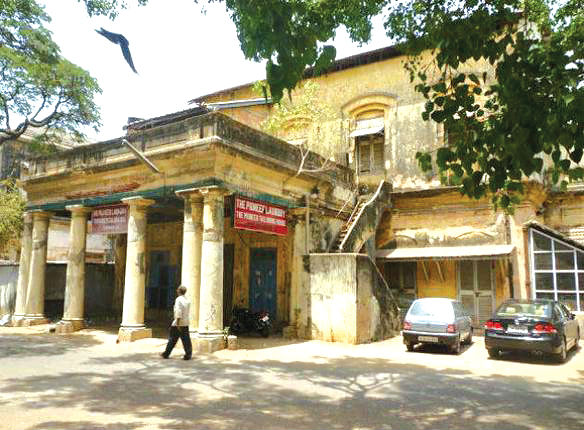Registered with the Registrar of Newspapers for India under R.N.I 53640/91
Vol. XXVII No. 12, October 1-15, 2017
Lost landmarks of Chennai
SRIRAM V
Laundry, auctions, where the Masons were

In its last days… the Pioneer Laundry building, once a Masonic Lodge.
For years it stood, just beside the LIC building and completely dwarfed by it. It was best known by the name of its last co-occupant, the other being the famed auction house of Murray & Co. But the building, with its colonnaded portico had a far more interesting history than that, for it began life as a Masonic Lodge.
The building, or whatever structure existed on the site earlier, first finds mention in 1849 when the Lodge Pilgrims of Light met there. This was a short-lived body, for it died out in 1862, but its meeting place was evidently quite popular for we find that by 1877 the Lodge Perfect Unanimity (PU), today the oldest Masonic body in South India, was thinking of acquiring it. PU had in 1839 embarked on building its Masonic Temple by the beach. The Lodge was however not happy with the structure when it was completed at enormous expense. It would later be sold to the police whose headquarters it remains till day. In the meanwhile PU moved to Vepery and by the late 1870s was considering a shift to Mount Road.
The property, known by then as the premises of Mr Garratt the tailor and spanning 100 grounds (around 6 acres), was acquired in 1883 for Rs 18,000. Shortly after moving in, members began complaining about the place. The existing bungalow was not suitable for meetings and suffered from poor ventilation. The installation of two punkahs at the cost of Rs 150 did not help. It was then decided that a new building had to be put up on the surrounding land, of which there was plenty. But of money there was none, all of it having been spent on the purchase and initial repairs. Building a first floor room for meetings was considered more practical and to fund this, the Lodge borrowed money. Wor. Bro. R.F. Chisholm, the well-known architect, designed the room, which strangely enough had no roof other than thin timber beams. This was fine on clear nights, but when it rained the place was a mess.
Moreover, rats, owls and birds began to reside in the rafters. Mangalore tiles were considered but were ruled out on the grounds that the timber could not bear their weight. Tarpaulins were eventually resorted to, in 1887. The groundfloor became the dining room.
Financial difficulties continued to dog the Lodge PU, chiefly because of the building. Moreover, the weight of the first floor, the light roof notwithstanding, had caused the ground floor walls to bulge out. Parts of the property facing General Patters Road were sold in phases, all of them eventually becoming the plot on which the firm of WE Smith would build its landmark Kardyl (now Bharat Insurance) Building.
Renting out the compound for grazing cattle and growing fruit at Rs 8 a month to Gopal Pillay brought in some revenue, as did leasing a disused wing of the bungalow to Masons. Electric lights were used for an installation ceremony as early as in 1890 and by June 1st, 1891, piped water from Red Hills was available.
But the property proved a cash guzzler. With the Lodge PU facing financial difficulties, it was decided in 1905 that the property be sold to the District Grand Lodge of Madras (DGL), the apex body for Freemasonry. With that building became the home and meeting place of all the Masonic lodges in the city. But complaints continued unabated. The DGL finally opted to move to its present property in Egmore in 1916, disposing off its erstwhile home to Kushaldoss Chaturbhujadoss, the Gujarati magnate. He in turn leased a part of the building in 1918 to Pioneer Laundry. In 1927, the remaining portion was leased to Murray & Co.
That was not the end of it. In 1951, MCt Chidambaram Chettyar acquired the entire property, land, bungalow and all. On the open space beside the old building he put up his dream edifice, a 14-storeyed structure to house his United India Insurance. This was completed in 1959 by when insurance had been nationalised and Chettyar himself was killed in an air crash. With that the entire property including the Bharat Insurance building and the old Masonic temple became LIC’s.
The structure also served as the office of the advertising agency O&M and in that capacity played host to ad legend David Ogilvy who described it as a cross between a church and a barn. Whatever it was, it survived as a reminder of a more gracious era. That was until 2015 when LIC, for presumably reasons similar to those that make it neglect Bharat Insurance building, demolished the Masonic temple, thereby obliterating history of a century and more.

